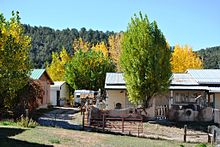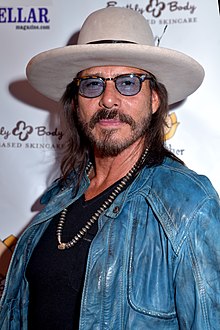Genízaros

Genízaros was called from the 18th to the 19th century in New Spain New Mexico and the adjacent southern Great Plains ( Texas ) Indians of different tribes (mainly Plains tribes of the south, no Pueblos ), the culture of the Spanish-born majority society assimilated and had been either Servants lived in Spanish households or in their own settlements.
It is estimated that around 10 to 30 percent of the sedentary population in colonial times consisted of such people.
In 2007, their descendants, from marriages between Indians were Hispanics and white Americans have emerged (see also: mestizos ) , and today as a separate ethnic group understand by the government of New Mexico under the name Genízaros as indigenous group recognized.
etymology
Due to the very similar pronunciation of Genízaros and Janissaries in English as well as a similar history of these two ethnic groups, it is often read that the term derives from the Janissaries , an elite group of Ottoman rulers, which consisted of captured Christians who later converted to Islam.
The second thesis is derived from the Spanish word root * geno- - for descent or race - with the suffixes -izo - person of action - and -aro - group. In an 1872 letter, Brother Juan Augustin Morfi stated, “This name is given to the children of prisoners of different nations who got married in the province.” The term was then used to refer to Indians of different tribes who were born in their tribal societies, but lived in the Spanish culture of New Mexico.
history
When the term Genízaros came up in the early 18th century, it was used in a pejorative way for Indians of various nomadic tribes of the southern prairies and New Mexico who lived among the Spanish-born settlers and were largely Hispanic . Originally they were prisoners of war or slaves of rival tribes who were ransomed by the Spaniards . Under the pretext of educating the “ barbarians ” in the care of a Spanish landlord to become Christian and “civilized” people, they were used as forced servants or workers. The majority were children and women who were welcome because of the labor shortage. In this way, some Genízaros were able to buy their way out over time. However, this did not improve their low reputation.
They could only improve their social status by serving the New Spanish government: Either they made themselves available as settlers for the establishment of localities in the constantly contested border area and thereby proved their loyalty in the fight against hostile Indians. Their knowledge of Indian languages and cultural peculiarities were often helpful. The strategic planning of these new settlements between 1740 and 1800 was crucial for the Spanish presence in New Mexico, to protect the cities of Santa Cruz , Santa Fe and Albuquerque as well as the missionary congregations among the Pueblo Indians from attacks by the Navajo , Ute , Comanche , and Apaches To protect Kiowa (the Genízaros also originally came mainly from the above-mentioned peoples).
Some Genízaros made a name for themselves as particularly skilled fighters. Such tasks were associated with great risks, but were also materially rewarded through land ownership. This settlement policy led to the emergence of some places (such as Belen , Abiquiú and Socorro ), which in the early days were exclusively inhabited by Genízaros and encouraged the formation of their own cultural identity . Over the course of a few generations, the characteristics of Spanish culture became more and more prevalent.
After the end of the Mexican-American War in 1848, the border moved far to the south, so that the settlements were now inland. With the spread of Anglo-American culture, the term genízaros fell into oblivion. In addition, the replenishment ended when Indians were captured again.
At that time, however, the members of the Genízaro communities already saw themselves as an independent ethnic group and culture, whose efforts led to state recognition as an indigenous people in 2007. They currently make up much of the population of the South Valley neighborhood of Albuquerque, as well as significant portions of the population of northern New Mexico and southern Colorado.
Famous Genízaros
- Raoul Trujillo (* 1955), actor, dancer and choreographer
Individual evidence
- ^ A b c Moises Gonzales: The Genizaro Land Grant Settlements of New Mexico. Journal of the Southwest, 2014. Volume 56, pp. 583-602. DOI: 10.1353 / jsw.2014.0029 , online , accessed on November 25, 2019.
- ↑ a b c d David J. Wishart: Genízaros , keyword in the Encyclopedia of the Great Plains University of Nebraska, Lincoln 2011, accessed online November 25, 2019.
- ^ House Memorial 40 , 48th legislature - State of New Mexico - first session, 2007, online , accessed November 26, 2019.



